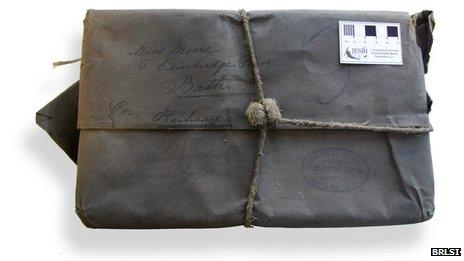Museum of Somerset marine insect fossil study starts
- Published

Most of the fossils from Strawberry Bank were found in this package found in the Taunton collection
A collection of 3,000 marine fossils "rediscovered" at the Museum of Somerset two years ago has now been curated by fossil experts.
The fossils were excavated by the geologist Charles Moore during the 1800s at Strawberry Bank near Ilminster and other sites around the South West.
Since these items were catalogued, it has been discovered they are the remaining 15% of the larger Strawberry Bank fossil collection which had been "missing" for several decades.
This now means the collection Moore wrote about in his diaries is fully restored and accounted for.
Jurassic insect diversity
The Strawberry Bank fossil collection is considered to be rare and unusual by experts because of the detail in the muscles, guts, and traces of skin of the insects and fish.
.jpg)
Some Taunton fossils were found wrapped in newspapers which are also being preserved
There is also the possibility there could be new species among the collection although it will take time before this is established.
The Bath Royal Literary and Scientific Institution has been overseeing the project to restore the Strawberry Bank fossils.
Matt Williams, the collection manager for the project, said: "If there are new species among the insects, it's important as palaeontologists are always interested in the diversity of prehistoric ecosystems.
"Often new fossil [extinct] species also help us to understand the evolutionary history of groups of living [extant] animals."
'Big flashy stuff'
Now the fossils in Taunton have been fully catalogued, research work can begin.
Mr Williams said: "About 15% of the collection I looked at was from Strawberry Bank and there were over 500 specimens of insects that could be identified at order level.
"There were nine different orders - dragonflies and damsel flies, cockroaches, earwigs, grasshoppers, crickets and locusts, true bugs, beetles, flies, scorpion flies and lacewings."
All of the fossils date back to 183 million years ago during the Jurassic period.
The collection also offers an insight into Moore's approach to fossil collecting.
"He didn't have a collecting bias towards larger fossils," explained Mr Williams.
"Some collectors in the past have only collected the big flashy stuff and have ignored the tiny little things.
"But here we've got the entire fauna so we can look at the ecological interrelations of the animals and start to produce a really interesting narrative both in terms of science and communication about the history of that area."
Mr Williams has worked with Dennis Parsons at the Somerset Heritage Centre, Somerset Archaeological Natural History Society, which owns the collection, and leading insect fossil expert Andrew Ross, from the Museum of Scotland, to get the Taunton collection curated.
'Perfect detail'
However, the quality of the collection has been variable.
"They're not as well preserved as the fish and the reptiles from that locality [Strawberry Bank]," he said.
"Obviously they are fairly well preserved that they can be identified to that level - some of those fossils that I was looking at I couldn't see at all but Andrew [Ross] who's a real expert could tell me what it was.
"That said, you could see some of the wings in perfect detail - so it is quite variable but enough to be quite informative about the animals that were living there."
He said the variation was due to the type of limestone the fossils were excavated from, which can reduce the level of detail - or resolution - of the specimens.
The hope now is to learn more about the fauna during this period and attract further research.
"We'll try to get some more researchers to work on specific elements of it now we understand what the different things are - say for people who are particularly interested in scorpion flies from that age, or insects from that age, we'll do something on that," Mr Williams said.
"We'll see if we can look at broader relations, such as the trophic relationships, what was eating what from that locality."
- Published11 May 2011